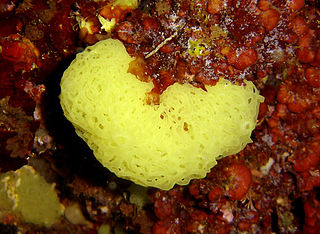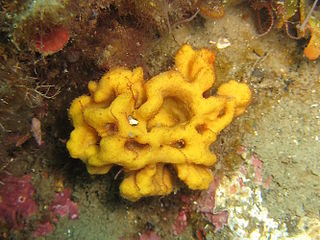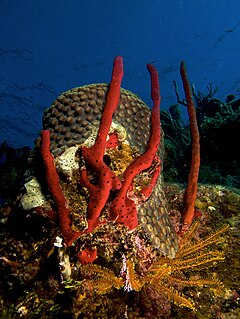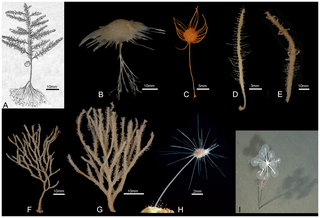| Gelliodes fibrosa | |
|---|---|
| Scientific classification | |
| Kingdom: | Animalia |
| Phylum: | Porifera |
| Class: | Demospongiae |
| Order: | Haplosclerida |
| Family: | Niphatidae |
| Genus: | Gelliodes |
| Species: | G. fibrosa |
| Binomial name | |
| Gelliodes fibrosa | |
Gelliodes fibrosa is a species of sponge found in shallow water in the Indian Ocean. It was first described in 1905 by the British zoologist Arthur Dendy, the type locality being the Gulf of Mannar, Sri Lanka. [1] In 1925, the American zoologist Edmund Beecher Wilson described a species of sponge from North Sulawesi as Gelliodes fibrosa. In 2013, Carballo, Aquilar-Camacho, Knapp & Bell, decided that this was a homonym, a separate taxon from the original one described by Dendy, and gave the new species the name Gelliodes wilsoni. [2]

Sponges, the members of the phylum Porifera, are a basal Metazoa (animal) clade as a sister of the Diploblasts. They are multicellular organisms that have bodies full of pores and channels allowing water to circulate through them, consisting of jelly-like mesohyl sandwiched between two thin layers of cells. The branch of zoology that studies sponges is known as spongiology.
A species description is a formal description of a newly discovered species, usually in the form of a scientific paper. Its purpose is to give a clear description of a new species of organism and explain how it differs from species which have been described previously or are related. The species description often contains photographs or other illustrations of the type material and states in which museums it has been deposited. The publication in which the species is described gives the new species a formal scientific name. Some 1.9 million species have been identified and described, out of some 8.7 million that may actually exist. Millions more have become extinct.

Arthur Dendy was an English zoologist known for his work on marine sponges and the terrestrial invertebrates of Victoria, Australia, notably including the "living fossil" Peripatus. He was in turn professor of zoology in New Zealand, in South Africa and finally at King's College London. He was a Fellow of the Royal Society.










